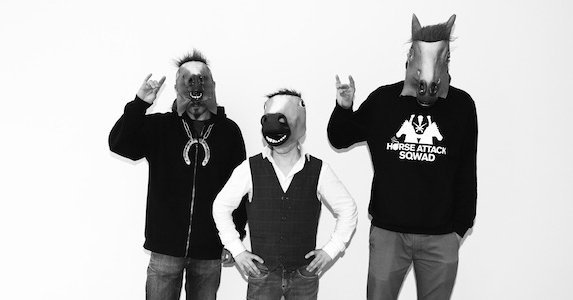This article features strong language, and language that may be considered offensive by the reader.
Älä koske mun hevoon (2015, “Don’t Touch My Horse”) features the cult track ‘Hevosia ei ongelmia’ (‘Horses No Problems’) which helped the self-described pioneers of Finnish grime rise to fame. The group’s second album, Suuren Yli-Hevosen armosta (2018, “From the Grace of the Great Over-Horse”), peaked at #6 on the official Finnish charts upon its release.
The grime group’s singular attire and unusual lyrical thematology have frequently given rise to doubts as to whether the anonymous artists, going by the names V65, Sylvester Stallion and Hevoskuiskaaja (‘Horse Whisperer’), are serious. The rappers invariably and adamantly assert that they are. Whether or not HAS are just horsing around, it’s intriguing to analyse their worldview, and their contribution to our shared cultural space.
Crossover between the modern and the traditional
Counts hooves at the stables all night / slashes and burns a meadow for the horse from the ashes. / Full working day counting sheep / I have a horse, I have what it takes. / Last cig, lifeline. / Indigenous horses, the horse is the base. / Villilä’s HD document, packs into a zip, into a workbench. / Testament of Killilä, of Villilä, the horse is the President. [1] [2]
– Talleilta bwoy (2015, ‘From the Stables Bwoy’)
After the initial amusement, what strikes a listener is the astuteness with which HAS presents a vivid account of a traditional, horse-centred lifestyle through means of urban, modern music. Horse Attack Sqwad’s very existence is a poignant reminder of the rapid development that Finnish and other European societies have witnessed in the past few decades.
As late as in the 1940s, the Finnhorse played a crucial role in Finnish society as a transport device. Tapio Rautavaara’s iconic ‘Juokse sinä humma’ (1953, ‘Run, My Little Horse’) is a musical illustration of the emotional attachment that many a workman would develop to their horses. Galloping urbanisation has since then cast a thickening veil of oblivion on a range of practices and phenomena so familiar to our great-grandfathers. Horse Attack Sqwad’s grime represents an effort to reconnect young generations with a past nearly forgotten.
Whilst familiar with the agricultural lifestyle, HAS are evidently also in the know about rap classics depicting life in the inner cities. Their lyrics harness the juxtaposition between the two starkly different environments, creating an occasionally humoristic effect. ‘Talleilta bwoy’, both in the song title and in the chorus, makes a cross-textual reference to Big Lurch’s ‘Texas Boy’ (2004). ‘Grime’, another one of the tracks featured on HAS’s début album, starts off with an English-language lyric highly reminiscent of the hook in Dr. Dre’s ‘A Nigga Witta Gun’ (1992): “Who’s the horse with the masterplan? The motherfucking horse with a gun”. [3] The gap between our past and our present has grown so wide that it could only be navigated by a unique and culturally aware collective such as Horse Attack Sqwad.
Political commentary in HAS lyrics: Confrontation or friendship?
HAS’s breaking of artistic conventions is not limited to the equine lyrics. In fact, the introduction of one unusual element has enabled Horse Attack Sqwad to also discuss other themes usually absent from rap. In the début album, violent themes characteristic of rap are admittedly near-omnipresent, although violence is normally inflicted using items such as pitchforks, horseshoes and poles, or simply piles of horse manure into which tresspassers’ faces are forcibly pressed. However, the second album addresses themes such as grief, longing, fear of death and search for a higher purpose - topics scarcely discussed by other prominent Finnish grime acts such as Töölön Ketterä.
You left half-eaten carrots behind you at the feeding trough. / I gently gathered them up and froze them / In case you still come back. / [...] I carried a sugarloaf to your monument. / Even though agony is still directing me, I promise to you that I will stand back up on my feet in order to spend each second of my life on being good to horses. [4]
– Hevoseni kuoli, Pt. 4 (2018, ‘My Horse Died, Pt. 4’)
Political commentary and historical references feature throughout Horse Attack Sqwad’s discography. Depictions of horses defecating on a snobby man’s shoes (in ‘Voit olla mies’, ‘You May Be A Man’) and on a Ferrari bonnet (in ‘Ratsastan’, ‘I’m Riding’), as well as the assertion that marks, euros, rubles and flaunting are needless when there’s a party at the stables (in ‘Nosta ilmaan kavio’, ‘Raise A Hoof In The Air’), indicate a rejection of the materialistic values that mainstream rap music has been associated with.
The three horsemen certainly show no solidarity towards tresspassers but the HAS lyrics that may be interpreted as veiled political statements appear staunchly pro-solidarity and pro-European. In ‘Hevonen on presidentti’ (2017, ‘The Horse Is The President’), the horse is presented as a heroic head of state who, among other things, wins the race to the moon and gets elected unanimously without abusing electoral funding rules. Notably, negotiating the Schengen Agreement is presented as one of few achievements of the horse that directly draw from historical events. In ‘Hevosia ei ongelmia’ already, the squad had exhibited its favourable attitude to international solidarity by indicating that giving horses to Greece is not a problem, even though the song is otherwise underpinned by aggressivity and vigilant guarding of one’s horses.
I’m gazing at the skies above the stables. In the Over-Horse we are all one, but I cannot reach such heights yet. [5]
– Hevoseni kuoli, Pt. 4 (2018, ‘My Horse Died, Pt. 4’)
Overall, it seems fair to conclude that despite the seemingly playful nature of the musical act, Horse Attack Sqwad is not only capable of profound reflection in its lyrics, but is also favourable to international solidarity. Perhaps the pioneers of horsely grime, in between the frequent depictions of violence, are in fact telling us a story of our societies’ progression from parochial communities where life was simple towards a global village guided by principles of modesty and unity − and love for horses.
Men know national borders, but horses do not. Judging by subtle references in Horse Attack Sqwad’s lyrics, Hevoskuiskaaja, V65 and Sylvester Stallion may well fulfil their dream of dying as horses.


Follow the comments: |
|
